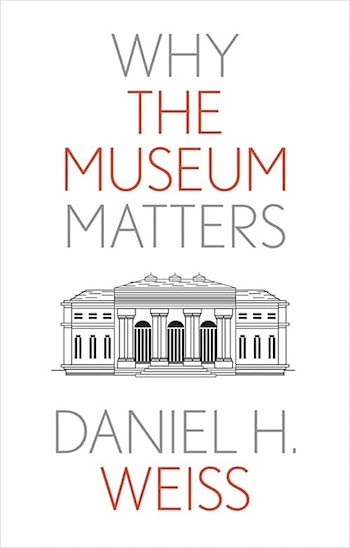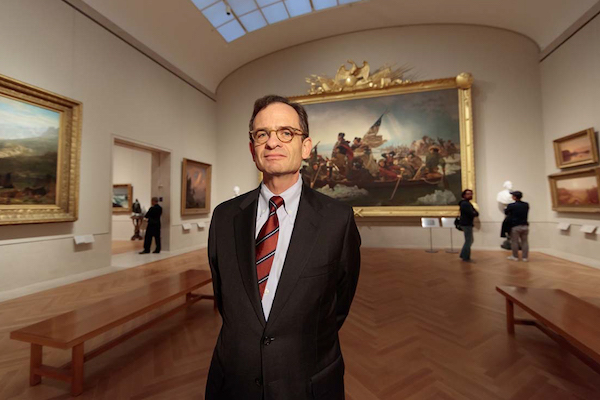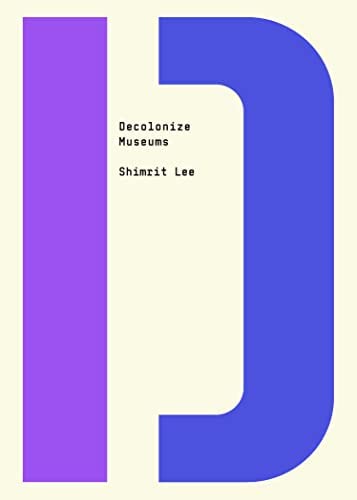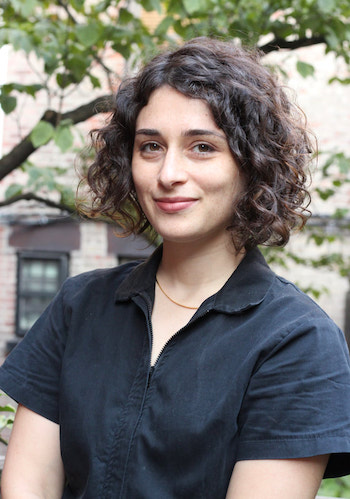Book Reviews: Art Museums — Anything But Neutral
By Peter Walsh
It’s tempting to frame these books as opposing sides in an argument, Old School Establishment vs. Progressive Left. They are more like parallel universes; their opinions and even their terms rarely converge.
Decolonize Museums by Shimrit Lee. Or Books, 296 pages, $20 (paperback), and Why the Museum Matters by Daniel H. Weiss. Yale University Press, 224 pages, $26.
 It’s been a tough few years for American art museums. First there was the pandemic, which shut most of them down and caused a steep drop in revenue. In response, the Association of Art Museum Directors suspended, for the first time, its once iron-clad rule that museums couldn’t sell art out of their collections to keep the staff paid and the heating on. Then the attention of pandemic-era social movements like Black Lives Matter and “cancel culture” turned in the direction of museums, questioning the moral status of their collections and policies.
It’s been a tough few years for American art museums. First there was the pandemic, which shut most of them down and caused a steep drop in revenue. In response, the Association of Art Museum Directors suspended, for the first time, its once iron-clad rule that museums couldn’t sell art out of their collections to keep the staff paid and the heating on. Then the attention of pandemic-era social movements like Black Lives Matter and “cancel culture” turned in the direction of museums, questioning the moral status of their collections and policies.
Issues that had always been swirling in the background became much noisier. Labor unrest flared up at New York’s progressive New Museum. A prominent West Coast curator was canceled out of his career for using the phrase “reverse discrimination” in connection with collection policy at the San Francisco Museum of Modern Art. Demands for repatriation became so loud that some museum officials began to imagine their galleries emptied of art. The prominent photographer Nan Goldin, outraged at the revelations of the role the art patronizing Sackler family and its Purdue Pharma played in the opioid crisis, demanded the removal of the Sackler name from all the many museums and galleries that currently carry it. Would-be stakeholders from all parts of the political spectrum insisted on the removal — from museum galleries and exhibitions as well as public spaces — of works of art that they found offensive or disturbing. Activist groups have splattered paint or food on museum buildings and their most famous masterpieces to call attention to political causes from Palestinian rights to the role of the oil industry in climate change. In the spring of 2021, an alliance of protesting groups organized “Strike MoMA,” a 10-week initiative, including “unauthorized acts of disobedience and noncompliance” targeting the “toxic philanthropy” of the museum’s leadership and forcing the resignation of key museum trustees. And the beat goes on.
Two books published this year take a look at art museums in their season of discontent to examine what their role is and should be in the 21st century. Why the Museum Matters is written by Daniel H. Weiss, president and CEO of New York’s Metropolitan Museum of Art, who holds a Yale MBA and a PhD in art history from Johns Hopkins. He came to the Met after a considerable career as an academic administrator, including the presidency of two colleges. Decolonize Museums is part of OR Books’ series Decolonize That! (forthcoming titles include Decolonize Self-Care and Decolonize Drag). It’s author, Shimrit Lee, earned her PhD in Middle Eastern Studies at NYU and she teaches at the Brooklyn Institute for Social Research.
It’s tempting to frame these books as opposing sides in an argument, Old School Establishment vs. Progressive Left. They are more like parallel universes; their opinions and even their terms rarely converge. For Weiss, the “museum” is the Metropolitan, and a handful of elite institutions like it, with a noble purpose and a proud intellectual history going back to the Roman Republic and beyond. For Lee, museums are part of a long, dark narrative of racism, repression, imperialism, exploitation, appropriation, physical and mental control, and propaganda for White Supremacy. Both authors tend to stumble around their subject, avoiding areas that might trouble their arguments, though Weiss does a more contentious job of considering arguments on the other side. Both books have significant gaps and omissions.
Weiss writes in the bland, anodyne, slightly patronizing tone that art museums often use to communicate with their visitors. His book is not a work of scholarship but is intended for general readers, “to offer an accessible narrative on the origins and history of the art museum, the larger purpose of such institutions, and what steps we might take for museums to achieve a better future.”
In Part I, “A Selective History of the Art Museum,” Weiss identifies the first public art museum as the Monumenta Pollionis, named for its instigator, which seems to have been a library and some kind of sculpture garden or court, installed, during the late Roman Republic, in a symbolic recycled building called the Atrium Libertatis (Hall of Freedom). Not far from the Forum Romanum, the complex was, Weiss explains, “established to support the idea that liberty could still live.” Weiss’s museum creation myth is not especially convincing, though — partly because so little is known about the nature of the invention, partly because the Monumenta Pollionis was a one-off, swept away in a later imperial urban renewal project, and not repeated for more than 17 centuries.

Daniel H. Weiss, president and CEO of New York’s Metropolitan Museum of Art and author of Why the Museum Matters.
Weiss traces the intellectual history of the modern art museum to the Enlightenment ideals of equality and public benefit, influencing the founding of the Louvre and the British Museum in the 18th century. But the great period of art museum expansion was a century later, in the context of industrialization and the creation of the modern nation state. And, when he reaches the origins and unexpected growth of American art museums, Weiss leaves out some major parts of the story. One is the influence of London’s South Kensington Museum (now the Victoria and Albert or V&A) and its mission to provide examples of good taste for manufacturers. It promulgated the notions that art should be educational and uplifting, welcoming to all classes (especially working-class artisans), and that it should embrace examples from all media, not just painting and sculpture, from all parts of the globe.
Besides original works, the V&A also assembled, when originals were out of reach, collections of plaster casts and photographs, an idea widely imitated by the first North American museums, where important European works were scarce indeed. Later on in his book, Weiss notes with disdain that early American museum collections contained “even a few plaster casts.” In fact, plaster casts, most often of famous Greek and Roman works, were a major part of almost all of the earliest American art museums. The V&A itself displays a large number of its casts in a special gallery, and a few American museum cast collections, including those of the splendid Slater Museum at the Norwich (CT) Free Academy, have been preserved mostly intact.
Weiss also leaves out of this brief history two other important foundation blocks of American art museums. One is the professional field of scientific art conservation, which changed ideas about how art should be displayed and cared for and considerably lengthened the life span of works in museum collections. The other is the tremendous, even overwhelming, influence of money. It was above all the great tycoons of the pre-income-tax Gilded Age, like J.P. Morgan and the Rockefellers, men and women of a period, social class, and nation not previously known for its good taste, that provided the funds to acquire major works of art and built institutions like the Met and the Museum of Modern Art that rivaled their sisters in Europe. The cosmopolitan, upper-class tastes of these men and women and their advisors determined, above all else, which art works were exhibited in American museums and which were not.
In Part II, “A Place of Consequence,” Weiss gives significant space to art museum architecture, an interesting choice because of the traditional split between museum visitors and museum staff over the institution’s essential nature. For visitors, the museum tends to be a place; for curators, it is the collection — the building is always an envelope to be pressed against — it is almost always too dark, too inconvenient, too intrusive, too cramped, or too small for its precious contents. In fact, most American museums have had more than one address, and some, including New York’s Whitney and Boston’s Institute of Contemporary Art, have had many.
In later parts of the book, when Weiss discusses the controversies and challenges around art museums today, his tone grows darker and his style more distanced and bureaucratic. “[The American art museum] is a civic enterprise held in trust for the public, with the expectation of widespread representation across its range of activities and within its systems of governance,” he explains. “[It] is often a site of public contention and disruptive activism due to the tension that inevitably results from navigating such ambitions with a rapidly changing and polarized society.”
Weiss surveys the critiques of various activists who challenge the art museum’s claims to political neutrality (in part, this is a requirement of laws preventing nonprofit organizations from taking partisan positions) and charges of the apparent separation of museums “from the rest of society.” Working from an apocalyptic viewpoint, when “the very foundations of democracy seem to crumbling around us,” activist Laura Raicovich claims that “[N]o museum is neutral, nor has it ever been. Indeed, from their very outset, museum structures have reflected a vast inequity of both power and wealth.” “Some activists,” Weiss acknowledges, “such as Hannah Baker and the group ‘Decolonize This Place,’ (DTP), go much further, calling for the complete abolition of cultural institutions in their current form as a necessary step for building anew.” Moreover, Weiss continues, the “very success [of art museums] as public institutions has made them highly visible platforms to be used for expressing other demands, including racial justice, indigenous rights, a free Palestine, degentrification, and global wage equity, among others.”
In a final chapter, “Museums for a New Generation,” Weiss outlines his hopes for the future of the art museum. He puts great faith in what he calls the “universalist museum” and belatedly acknowledges the role of rich American collectors for providing the groundwork for it in thousands of donated objects at the Met. “By the middle of the twentieth century, the new ambition was for many [American art] museums to become, ‘encyclopedic,’ a designation signaling the desire to possess the art of every culture — even if thoughtful people recognized that such coverage was actually impossible to achieve.… This is why the term ‘universalist museum’ is both more accurate and represents a better way forward.”
After outlining the many governance and financial challenges facing the universalist ideal, Weiss concludes his narrative on an uplifting note. “If the universal idea is increasingly resonant with the knowledge and values of museums today, it also serves as a compelling vision for how we can build stronger connections with others. The museum of the future will find meaning in difference and power in unity, with each culture represented within its collections recognized as part of a great constellation, both distinctive and interconnected.”
 In her preface to Decolonize Museums,” series editor Bhakti Shringarpure, the editor-in-chief of Warscapes magazine, outlines some of the more horrifying colonial episodes recounted in Lee’s text. Her conclusion runs worlds away from Weiss. “[D]ecolonizing is certainly not enough,” she writes. “There is a litany of words we need to add to support collective action against this mammoth institution: defund the museum, strike against the museum, boycott the museum, abolish the museum. This book did me in and it will most likely do the same for you. I’ll never set foot in a museum again. Perhaps, you will be moved to do the same.”
In her preface to Decolonize Museums,” series editor Bhakti Shringarpure, the editor-in-chief of Warscapes magazine, outlines some of the more horrifying colonial episodes recounted in Lee’s text. Her conclusion runs worlds away from Weiss. “[D]ecolonizing is certainly not enough,” she writes. “There is a litany of words we need to add to support collective action against this mammoth institution: defund the museum, strike against the museum, boycott the museum, abolish the museum. This book did me in and it will most likely do the same for you. I’ll never set foot in a museum again. Perhaps, you will be moved to do the same.”
Lee’s text is not quite as absolutist as this prologue might suggest. Lee is not in favor of abolishing the museum — quite — though her proposed reforms would radically change its contents and social contract. Her book, clearly based on extensive research, has more scholarly ambitions than Weiss and comes with a full bibliography and footnotes. But she makes clear early on that her text is not a leisurely tour of museum cultural history — it’s a polemic against the entire museum enterprise as it has evolved: “History shows us that museums have always been simultaneously beloved and contested spaces — ‘both the hand that feeds and the citadel to be stormed,’ as [art critic] Lucy Lippard put it.… That museums are today seen by many as ‘neutral’ is a testament to the extent that the histories of museum spaces have been buried by their modern operators. To examine those histories is to know that museums are really crime scenes … spaces that house the memories of atrocities committed during the colonial period, including theft, murder, and genocide.”
Lee’s book suffers from a lack of clear definitions. Key terms — “colonize,” “imperialism,”“museum,” and “theft” — are particularly expansive and rubbery, often stretched to fit her argument of the moment. “Colonize” and “colonial” are notoriously ambiguous, politicized terms, and Lee’s narrative might have been stronger if she had pinned her usage down somewhere in the context of the new academic discipline of Postcolonial Studies. Her functional definitions emerge as deeply based in race — that colonialism is a sustained and brutal attack by people of European origin on people of color. She says little to nothing of episodes of colonialism not focused directly on racial conflict, such as the highly organized colonial projects of Ancient Greece, Roman control over the Mediterranean Basin, the medieval Visigothic colonization of Roman Spain and North Africa, the English colonization of Ireland, the Norman conquests in England, France, and Sicily, the jihadist Arab conquest of the Persian Sassanian Empire, Inca expansion in the Andes, the Ottoman colonization of Anatolia, or Japan’s late-19th- to mid- 20th-century colonization of Taiwan and Korea, some of which were quite as brutal as the colonial episodes in Africa that she describes so vividly. Many of these episodes are also reflected in museum collections.
“Museum,” in Lee’s usage, is not even in the same dictionary as Weiss’s. At different points, Lee encompasses in the term: art museums, natural history museums, ethnographic museums, anthropology museums, archaeological museums, world’s fairs, P.T. Barnum’s “museum” of curiosities, grotesqueries, and hoaxes, the generic, figurative use of “museum” to mean “a group of related objects” (as in “Williams Sonoma is a museum of high-end kitchen gadgets”), even Buffalo Bill’s Wild West show. As a result, she tars with a very broad brush. Most of the time, she seems to be talking about ethnographic museums and related sections of other institutions — supposedly scientific establishments that were founded on 19th-century racist interpretations of systematic biology and Darwin — that attempted to classify and rank races, ethnic groups, and human societies, placing European civilization at the pinnacle. These institutions are now notorious for their past gruesome practices, in the name of science, of collecting human heads and remains and even imprisoning living “primitive” humans inside public exhibits. But science itself has moved on. The surviving unreformed museums Lee likes to cite are scientifically and culturally obsolete, fossilized relics of a racist Victorian past. (For an example of how contemporary ethnographic museums are dealing with some of these difficult historical issues, follow this link.)
Lee dismisses Weiss’s “Universal Museum” as a “fallacy” and a “harmful” concept. She spends much of her time on colonial Africa, calling repeatedly for the mass repatriation of the looted Benin Bronzes to Nigeria and the return of all other African and Indigenous art works forcibly removed from their contexts and now in Western museums (she assumes this is most of them, if not all). The European colonial period in Africa, however, came late in the 19th century, in a particularly rapid, brutal, and relatively short-lived episode historians often call “the Scramble for Africa.” In 1870, only 10 percent of Africa was under formal European control. By 1914, that had increased to almost 90 percent, with only Liberia and Abyssinia (later conquered by Italy) remaining independent. Half a century later, the continent was rapidly being returned to local control.

Shimrit Lee, author of Decolonize Museums.
For centuries before that, contact between Europe and the Middle East and Africa was mainly through missionary efforts (Christian and Muslim) and commercial trade, including a flourishing and reprehensible trans-Atlantic traffic in slaves. In Lee’s analysis, no contact between white and non-white peoples could be fair or equitable. She writes of the “extractive nature of colonialism by which most of the Global South was robbed of culture, resources, and people in plain sight. This violence is not over for Indigenous and Black people…. The museum, with its white walls and white lights, aids in historical amnesia.”
But Lee’s survey of the cultural entanglements of the art museum remains incomplete. She says nothing, for example, about the tens of thousands of objects of East Asian origin in Western museums or, beyond the Elgin Marbles, much at all about the American expropriation of vast collections of European art and architectural elements during the Gilded Age. And it’s not clear how widely her African narrative applies to American art museums. In another twist of the racist lens, most of them did not collect or exhibit Indigenous or sub-Saharan works as art until the late 20th century. Many still do not. Ironically, including works from Africa, Indigenous America, and other parts of the world in American art museums was once intended as outreach to non-white visitors.
In later chapters, Lee is more positive. She praises the “new museology” which seeks to include African and Indigenous people in presenting their own visual cultural heritage and holds up the United States Congress’s Native American Graves Protection and Repatriation Act (NAGPRA) as a model to be copied globally. She applauds the growing number of museums that have already repatriated contested objects. By the time she reaches her conclusions, however, her indignation is boiling again over the practices of elite art museums. She describes the urban renewal and gentrification around new museums as “weaponizing” and museum and gallery collaboration with developers and corporate sponsors like ExxonMobil as “art washing.”
Such critiques have built-in limits. Unlike museums in the rest of the world, most American museums are private nonprofits and largely privately funded. The Federal government has never given more than a pittance to the arts in general and, as the right-wing politicians who attacked museum exhibitions they found offensive back in the ’90s discovered, there is ultimately little Washington or the general public can do beyond protest, shaming, and threats (so far unsuccessful) to defund what’s left of the National Endowment for the Arts.
“All art,” as George Orwell puts it, “is propaganda.” Thus the long history of museum-based controversies Lee describes in the past is destined to continue into the indefinite future. Weiss is unlikely to mollify many activists with his appeals to classic Western ideals and the “universalist” museum. The current leftist, guilt-tripping, “fingernails on the blackboard” approach to civic discourse is equally unlikely to resonate with the millions of American museum fanatics or convert art museums into platforms for social justice. Meanwhile, the eccentric, deeply human, contradictory, contentious, always imperfect and fascinating institution of the art museum will probably stumble on.
Peter Walsh has worked as a staff member or consultant to such museums as the Harvard Art Museums, the Museum of Fine Arts, Boston, the Davis Museum at Wellesley College, The Metropolitan Museum of Art, the National Gallery of Art, and the Boston Athenaeum. He has published in American and European newspapers, journals, and in scholarly anthologies and has lectured at MIT, in New York, Milan, London, Los Angeles and many other venues. In recent years, he began a career as an actor and has since worked on more than 100 projects, including theater, national television, and award-winning films. He is completing a novel set in the 1960s.
Tagged: Daniel H. Weiss, Decolonize Museums, peter-Walsh, Shimrit Lee
